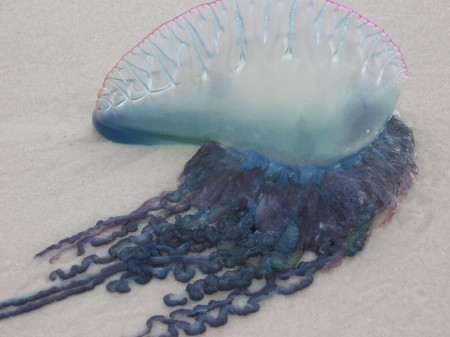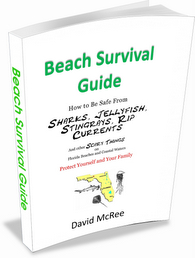Question: When is a jellyfish NOT a jellyfish?
Answer: When it’s a siphonophore or a chondrophore.
Prefer to listen to this blog post rather than read it? Click the play button on the player below. It’s about 5 minutes of me blathering on about jellyfish:
Recently I was taken to task in a politely pedantic comment left by one of my blog readers. She wanted to know why I consistently refer to the Portuguese Man-of-War (Physalia) as a “jellyfish,” when it is not technically a “true jellyfish,” but is a siphonophore. She is concerned that I am perpetuating mis-education.
She is absolutely correct that Physalia is not considered a “true jellyfish,” though it is related.
So why would I call them jellyfish if they are not?
When encountering something new, the human mind uses association to try to identify the object and determine its characteristics. In other words, the mind tries to find something that it is already familiar with that is in some way similar to the new object. For instance, when we encounter a new type of fruit, we can fairly quickly determine that this new object is some type of fruit by observing its physical characteristics and comparing it to other fruit we are already familiar with.
The same mental association method applies when John and Sally from Chicago are walking along a Florida beach enjoying their first Florida beach vacation and they encounter a Portuguese Man-of-War washing up on the beach. Even though they’ve never seen or heard of a Man-of-War, they have heard of jellyfish and have probably seen pictures and video of jellyfish. They immediately observe that this new object is a soft-bodied creature that swims in the ocean and has tentacles. Ah-ha! JELLYFISH!
Most people will be satisfied with that classification and will move on. Others will be more curious. They’ll snap a photo and want to figure out the name of the creature and whether it can sting.
When John and Sally go to the local internet cafe, or when they return home, they’ll turn to Google. They’ll type in search terms like “florida jellyfish,” “purple jellyfish,” “jellyfish with purple tentacles,” etc. They will not search for “siphonophore” or “man-of-war” or “hydrozoa” since they’ve never heard of those terms.
Since I used the word jellyfish in my posts about the Man-of-War, they’ll find my website or blog by using their natural search query. Once on my website or blog, they’ll learn the name of the animal and that it can be dangerous. If they want to know the taxonomy of the Man-of-War, they now have the information to turn to Wikipedia to investigate further.
I use the term jellyfish in my posts about the Man-of-War because it helps people find the information they are looking for.

A search for "Florida jellyfish" brings up my website and blog as the first three search results on Google.
If you’ll look at various newspaper and magazine articles you’ll find that a Portuguese Man-of-War is popularly referred to as a jellyfish. It is what people understand.
Scientists use the same association techniques when identifying things, except that they examine things much more closely. Scientists compare things like skeletal structure, types of organs, tissue and cells, and even DNA to determine how to classify that organism. They have a very complicated system of naming and classification called “taxonomy.” Taxonomic classification of various animals and plants is constantly being revised as new information (particularly new information from DNA testing) becomes available.
Scientists put jellyfish-like organisms in a group (phylum) called “Cnidaria.” (The “c” is silent). The Cnidaria category contains and classifies organisms that have stinging cells called nematocysts. Underneath Cnidaria are several sub-categories (Classes):
- Hydrozoa-includes siphonophores including the Man-of-War
- Cubozoa- includes the very dangerous box jellies
- Scyphozoa – includes “true jellies” which have a lot of gelatinous tissue called “mesoglea.” Example: moon jelly (Aurelia) and cannonball jelly (Stomolophus).
- Several other Classes, but let’s not get carried away.
You might have noticed that the infamous and sometimes deadly box jelly is not a true jellyfish either as it is a Cubozoan. Nevertheless it too is commonly referred to as a jellyfish.
A Man-of-War is actually not a single organism, but is a group of organisms (polyps) living together, though they appear as one. The same is true of blue buttons (Porpita) and by-the-wind sailors (Velella), which I also often refer to as jellyfish, which they are not–technically.
I am not a scientist, and I do not write for the scientific audience. After a brief consultation with a distinguished marine biologist, I consider it appropriate to continue to refer to all of these Cnidarians with mesogleal tissue as jellyfish.




